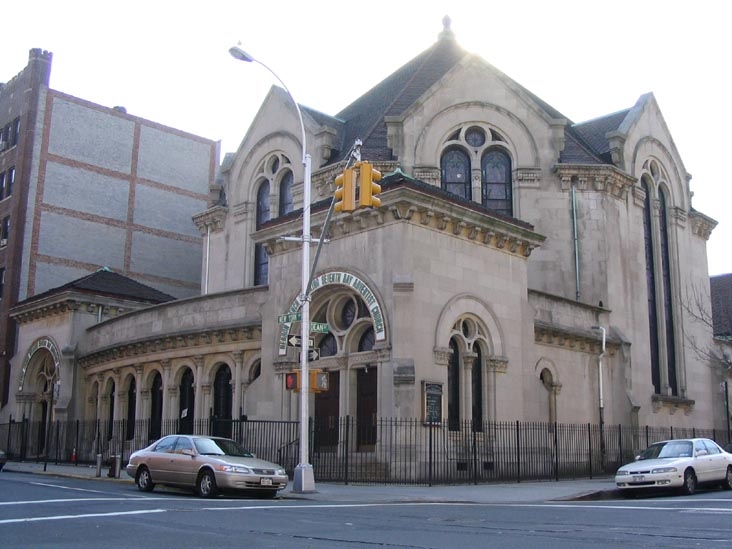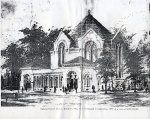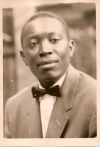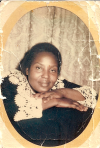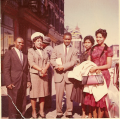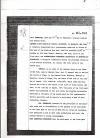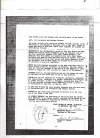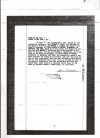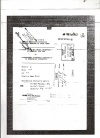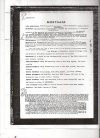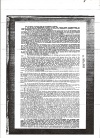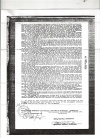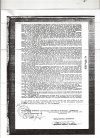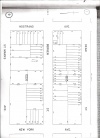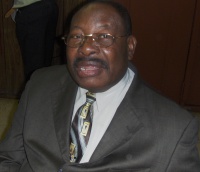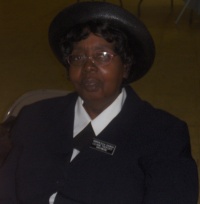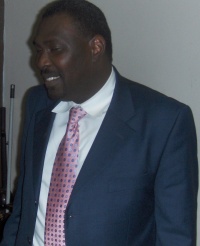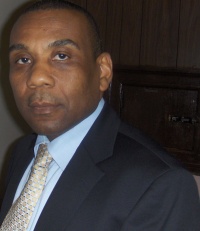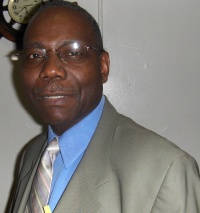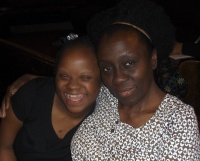User:S beaubrunFrom The Peopling of New York CityHebron Seventh- Day Adventist French-Speaking ChurchThe Research Proposal
I initially had several buildings and blocks in mind that I wanted to learn more about, however, after doing research, I narrowed my search down to two buildings. I first began to research an old school building located on Park Place and New York Avenue named Hebron Seventh Day Adventist Bilingual School. It was extremely hard because most of the people that could give me information about its history was dead. But I didn't give up mainly due to the fact that no one had attempted to find the history of the building before and it would make me proud to know that I was the first one who tried. I made several attempts going to the Grand Army Plaza, the local library, the Municipal Archives, as well as the NYC Office of Registry, and the NYC Department of Buildings. I made small discoveries concerning the school building such as the image of how it looked in the early 1900s as well as the deed to the school and the violations/inspections that they had to deal with. After these discoveries, there wasn't much left to find, so I turned my attentions to the other building that I had in mind, the Hebron Seventh Day Adventist French-Speaking Church. This church located on Dean Street and New York Avenue, just a few blocks away from the school, had a great wealth of information surrrounding it. With a historian that gave me a hand in the search for information about this building; I have posted together my narration of the Hebron SDA French-Speaking Church. Please, take a walk through my building. Why Did I Choose This Building?I was originally undecided on which street I wanted to choose. There were several buildings that I wanted to do research on. My first decision was to choose the Hebron Seventh Day Adventist French Speaking Adventist Church located on Dean Street and New York Avenue. My second choice was to research the Brower Park Library on St. Marks and Nostrand. I also had another choice of the Hebron SDA Bilingual School. I even had my mind made up on the Reformed Dutch Protestant Church on Church Avenue and Flatbush. But I decided to focus my research on the Hebron Seventh Day Adventist French-Speaking church because after weeks of spending time on a building that was leading me to dead ends, I chose to complete my research on the church instead. I attended this church for my entire life simply because my parents went there themselves. The only thing I knew about this church was that it used to be a synagogue that was bought by Seventh Day Adventists in the late 1900s. I realized that I had never paid much attention to its history and that this project would help to open my eyes to a world of discoveries. As I would later find out, this building stood for hard work, determination, faith, and the connection between heritage, language, and religion. As I paid closer attention, I began to see that many people who passed by the church were intrigued by the look of the church. This building takes nearly the entire block from New York to Nostrand. Truly, this project helped me to look back on Hebron's history and reminded me of all the hard work that immigrants went through in order to purchase a church that brought their religion, culture, and language together. This church created a family that would begin to spread to other parts of the world.
The Building Of 1256 Dean StreetThe Hebron French Speaking SDA Church was originally known as the First Church of Christ Scientist. Designed by Henry Ives Cobb, a MIT and Harvard educated architect, the building was inspired by the Byzantine Revival and constructed in 1909. [2] This church is also known as being located on 100 New York Avenue rather than 1256 Dean Street. It now serves as the district’s only representation of the Byzantine Revival style architecture. Located just on Dean Street and New York Avenue, the church was built during the time when the population of the neighborhood was increasing and various churches were emerging or expanding. The building is a symbol of the type of auditorium church that was popular close to the end of the 19th century.[3] The building is characterized by its stain glass windows, one story pavilions and arcade facing Dean Street and New York Avenue,Corinthian columns, as well as limestone steps with the entryway, and so on. ‘‘The church was built under three sequential new building applications, all of which identify Henry Ives Cobb as the architect. The church is distinguished by it complicated massing, consisting of a paired of hip-roof entry pavilions flanking a curved arcade and by its broad, multi-side hipped roof topped by a bronze turret.[4] The Origins of the Hebron SDA French-Speaking Church(With the help of the historian in Hebron SDA Church, we pieced together quite a terrific story of how the church began, progressed, and the different faces that not only pioneered it but helped it flourish). The building that now houses the members of Hebron SDA Chuch was orignally the First Church of Christ, Scientist in 1909. Once, the church was bought, the name Hebron was brought with them from the previous locations of where they had lived.
Initially, Hebron Seventh Day Adventist French-Speaking Church began on an August night, year 1956. There was a prayer meeting in the home of a woman named Sister Percide Valcourt at 570 St. Mark's Place. Paster Pierre-Louis was just passing through New York on a visit when he stopped at the prayer meeting and directed it with the encouragement of twelve to sixteen Haitian Adventists for two consecutive Saturdays who were in need of spirituality. On the following Sabbath after those two weeks, the Adventists met in the home of Kis and Anne Adrienne Lamour at 976 Prospect Place where they decided on a deacon,deaconess,treasurer,director/ress of Sabbath school, a secretary, as well as a condictor. The congregation continued to worship in the home of Mr. and Mrs. Lamour until they were able to rent a storefront on 1435 Bedford Avenue with the funds collected from the members which made sacrifices each week to give a tithe or offering that would amount to $75 up to $100. They even named the church "Eglise d'expression Francaise" which translated in english means "Adventist Church of French Expression." This name was especially significant due to the fact that they were the first Haitian, French-Speaking, and Advenist church in New York.[5] Their work did not stop there. They had several challenges when it came to renovating and furnishing the entire building. Several people came together including Kis Lamour, Luc Appolon, Pierre Belhomme to address these challenges. Each member gave three chairs and $80 every month with the generous contribution of the landlord's monthly $20.00 in order to make the $100 rent each month. Haitians in New York were spread out in American Churches depriving them of a sense of community and membership with people who were from the same culture. When the church was to join the Greater New York Conference, which was the sole federation for churches who were held in a foreign language, the Conference realized that these church members were black and recommended that they join the Northeastern Conference, which catered to churches in that region or a black federation. The Northeastern Conference accepted Hebron and sent them an American pastor named Pastor Ashby simply because he was the only pastor that knew a few words of French. However, because he could not effectively communicate with his congregation, his stay there was shortlived. The growing population wanted their own place to worship instead of a storefront, so in 1965, they bought a building at 349 Eastern Parkway (now presently is owned by the Northeastern Conference for the Shiloh Seventh Day Adventist Church) for $120,000. Members contributed to $25,000, the Conference gave $10,000 to the church,and they were left raise $35,000 before they could get the church on February 15, 1965. Left without a pastor that could speak French, it was not until ten years later that the Northeastern Conference delegated one of the founding members as the pastor, Pastor Rene Adrien. Unfortunately, when he began his ministry, his health began to decline and he died in March 1968. After his death, the conference elected an evangelist from Martinique named Pastor Matthew Bermingham to take over the church. Where did Hebron get its name? Under Pastor Bermingham's leadership, the members of the congregation chose to change their name from "Eglise d'expression Francaise" to "Hebron" since they were no longer the only French-Speaking Seventh Day Adventist church in New York. THe name "Hebron" was chosen because it meant in the bible "City of Refuge." The number of people attending the church continued to grow also bringing with it a security issue. The number of members coming to the weekly services were more than the building could hold. So, Pastor Bermingham suggested that the members who lived in East New York should go worship at Horeb SDA Church located on East 95 Street and that the members who lived in Queens should attend weekly services at Maranatha, a SDA church also located in Queens. However, the people loved their church too much that they would not leave as was recommended. Instead, Pastor Bermingham was reminded of a church building that he passed by several times located on Dean Street and New York Avenue. He had wanted to buy it for his growing church. So, he made a bid on it of $250,000. However, another church which is ironically now located across from Hebron named the Union United Methodist Church also made a bid of $400,000. But since the owner had promised the building to Hebron, they now had a place to worship. With the sale of Hebron's church building for $150,000, $25,000 from the Conference, and a loan, Hebron Seventh Day Adventist French-Speaking Church now resided at 1256 Dean Street, a former synagogue for Jews. [6]
During that time, Pastor Bermingham also played a central role in acquiring a building known as the Old Methodist Home, just a few blocks from Hebron SDA Church in order to promote Chrisitian education. The pastor felt that the church should also own a school in order to help the children in the Haitian churches as well as preserve the French language and provide them each with an Adventist education.[7] The Pioneers of the Hebron SDA French-Speaking ChurchThe hard work of these individuals helped to create the first Haitian French-Speaking SDA Church in New York. [8]
The Municipal ArchivesWhen I first went to the Municipal Archives, at first, I was lost. I couldn't find the building and was contemplating going back home. I only had two hours left before my class started but I wanted to find something about my building. After the aid of many, I located the building and went through security. Afterwards I went to the Archives and expected most of the information to be there in books that I would only have to go through. However, I was shocked when the head of the Archives told me to just go through the indexes and find the microfilm to look at in order to find what reel my block belonged on. I can honestly say that I wanted to cry because I didn't know what I was doing. After getting lost in Manhattan and finally finding the place only to hear that I would have to search for the microfilm myself, it was a little overwhelming. But I got myself together and went through the Desk Atlases for the Borough of Brooklyn. I accidentally went through Manhattan's book before I realized my mistake when I could not find my block. But I found the block and lot number and went to get the index in order to find a picture of my building. Finally locating the reel was great but fitting it in the machine was just complicated. I put the film upside down, couldn't get the tape under the black roller, than when I finally put everything together, I just could not find my building. With the help of a librarian, who saw me struggling and had pity on me, she took out the film put it correctly and showed me how to use the machine in order to find the reel that my building would be located on. After half an hour, even though it seemed longer, I found my building. It was under block 1213, lot 37. [9] After going through the indexes, I found the old picture of Hebron SDA Church located on Dean Street in the 1940s. The picture was not that clear when I made a copy of it. In fact, the building can hardly be seen but an outline of it is shown. However, I made two copies of the picture of the old building hoping that the second would come out better. (It didn't).[10]The Grand Army Plaza: Brooklyn Public LibraryI went to Grand Army Plaza: Brooklyn Public Library in order to do further research on my building. When entering, I immediately went to the Brooklyn Collections because I knew there was a possibility that I could find something about the building. However, when I went there, I mentioned to the librarian my building and how I was researching it for a project. She went to her indexes in order to look if there were any periodicals about my church. She couldn't find anything even when I mentioned to her that the church had undergone a name change. Nothing came up in the Brooklyn Eagle newspapers either. We checked both the names Hebron SDA Church and L'Eglise Expression de Francaise but nothing could be found for either. Even with this research block, I continued looking through a number of "Brooklyn" books in the hopes of finding even a small excerpt about Hebron. I didn't have such luck, however, the research librarian informed me that she would call me if anything turned up. I looked in the Brooklyn Eagle almanac under the listings for church and Seventh-Day Adventist, ironically I could not find Hebron's name there but I did see Hanson Place, which is another SDA church that was created from members of Hebron. Step 3: The NYC Office of RegistryIn the NYC Office of Registry, I found two documents that I considered containing a great amount of information on. The first one was of a deed between two parties, one of them being the Northeastern Conference and the owner of the 1256 Dean Street Church. The sell was made on September 27, 1977 between the First Church of Christ Scientist and the Northeastern Conference Corporation of Seventh-Day Adventists. It states that this order was entered in the Kings County Clerks Office on August 10th and was filed on the 11th. The property was paid for in the sum of $250,000. The deed grants the Northeastern Conference (second party), the property forever. The Chaiman and Clerk of the Board of Trustees of the First Church of Christ Scientist authorized the sell of their building to the Northeastern Conference. The second document I found was the mortgage. This document showed a loan from the Carver Federal Savings Bank that gave the Northeastern Conference $75,000, in order for them to acquire the building located at 1256 Dean Street. It gave the Conference a list of requirements that they had to follow as well as the financial responsibilities they needed to undertake for fear of losing the church. They agreed to pay on the first of the month as well as all of the taxes that are on the building. The last page of this document summarizes what I have briefly described above.
Step 4: The NYC Department of BuildingsIn the Department of Buildings, I spent a long time trying to find any information about my building. I looked for the Certificate of Occupancy, which would explain what the building was used for over the course of history, however, since the Office has just begun to record that type of data in the late 1930s, they told me that nothing could be found on my building. However, they said even if the time was in their range, they wouldn't be able to tell me anything because for most churches, there are no certificates of occupancies. I did find however, a photo of my building as well as details that tell of its history. In this photo, it discusses the construction of the church and the schematics of how it was built, the size, the area, and so on. It was essentially a plot diagram for the building located on 1256 Dean Street, also known as 100 New York Avenue.
I also found a tax photograph of my building and its surrounding area. It provides the square feet that the plot of land is on as well as details the block and lot number. When I saw the map which wasn't so hard to find, since my research skills have been developing, I was surprised to see how small the plot looked like. The church in real life, looks so big, that I expected to see a square that would take up nearly all of the block. However, this picture showed me just how different things look in paper than in real life.
Step 5: The Members of Hebron SpeakThere were a select number of members from Hebron SDA Church chosen to discuss how they first heard about the church, when did they come to the church, and what changes do they see the church undergoing. Here's what they had to say.
This is one of the three oldest and original members still alive in Hebron Seventh Day Adventist French-Speaking Church. He stated that he was with Hebron when it was first on Park Place in the living room of Mr. and Mrs. Lamour. He was there when it moved to Bedford Avenue then to Eastern Parkway and finally when it settled on Dean Street. Hebron was where he met his future wife, Justina Charles (her photo has been posted above), where he held the burial service when she died, where he met his future wife, and held the baby dedication for his now two year old son.
She was twenty-two years old when she came to Hebron SDA Church. She is the second oldest member of Hebron. She was in Haiti for most of her life then she immigrated to Canada for three years then to the United States. As I continued to talk to her, I transcribed what she had discussed with me onto this wiki. In her own words, she said " I had lived in Manhattan than I moved to Brooklyn. Someone who was a member of Hebron invited me there because there wasn't even a French-Speaking Church at that time and any Haitian that came to New York had to go to an American church to worship. When I came to Hebron, it was originally located on Bedford Avenue. I used to go to the SDA Church on Saturday morning then when I came home, I would put on all of my jewelry and go to the club at night. On Sunday morning, I would go to Catholic mass and at night I would go to the movies with my friends. After I came from mass, I always felt like something was missing. So I came to Hebron in order to feel a sort of connection with people that were like me. I was there for the church's dedication which was beautiful. Hebron was the only French-Speaking SDA Church in New York. Hebron wasn't even named Hebron until the church moved to Eastern Parkway. I voted "yes" for the name "Hebron" to be given to the new church because we weren't the only French speaking SDA church anymore. Our name needed to be changed." "Hebron was where I got baptized, met my husband, and got married. When I first came to Hebron, I would walk from my house in Jefferson to Bedford Avenue, where the church laid. My first friends from this church were Sr. Nicole Cadet (died in 2007), Sr. Jean Jacques (bed-ridden), and Sr. Leone Toles (retired in Pennsylvania). We were all single at that time. Now that I think about it, Sr. Toles is also one of the other oldest members of Hebron Church. We all met our husbands from Hebron. I had a SDA friend who I would visit his house on certain Saturdays. My husband saw me there and wanted to talk to me. I told him to go somewhere when he tried talking to me. It took him one year for us to start dating. He was also an SDA but I didn't know it because I never saw him when i went to church. I found out later onthat he had grown up being an Adventist although it took him twenty two years after we had married to finally get baptized. He transferred his membership to Hebron to be closer to me. Our children grew up in this children, all three of them got baptized her, went to Pathfinders, sang in choir, they did everything. My youngest child is 39 years old, that tells you how old I am (laughs). I don't even know how many friends now in this church. Let's just say that I'm everyone's friend whether they're Christians or not. Everyone in my neighborhood knows me. This church is my home now. I was here when this building (1256 Dean Street) was dedicated and had its first service. It was beautiful. I've been here for a long time. My final church will be in Hebron. The church is not the Hebron that I remember, it used to be crowded but now its empty. Most of the members moved, died, or went to other churches. Hebron seems to be dying, the church seems to be dying. If they were to decide to sell the church, I don't know where I'd go. I'm not going back to someone's apartment. The church is ours. The mortgage is paid, we own it. I don't know"(sighs). Sr. Bertha Heriveaux: Unfortunately, due to the fact that she takes care of her elderly mother and was unable to stay for the interview.
The Influence of the Pastors of Hebron SDA ChurchEach pastor had significant influence on the development of the SDA Church. With the help of the local historian, searching through Hebron's archives located in the attic of the church allowed me to discover the pastors from the beginning of the church and important changes they brought along with them. I selected the most influential of the eight pastors in the Hebron SDA Church that created significant change in the church. The Pastors of Hebron SDA ChurchPastor Adrien (1956-1968) . [15]He is best known for heading the first French Speaking SDA Church in Brooklyn,NY. It was with his commitment and hard working determination that Hebron SDA Church grew. Pastor Bermingham (1968-1979) . [16]Under his leadership, Hebron changed its name from L'eglise D'expression de Francaise to Hebron SDA French-Speaking Church. As he continued to preach at Hebron, his church continued to grow with Haitians coming from all parts of the country wanting to unite their culture. When the church continued to grow and became a fire hazard, he encouraged other Haitians to go to Horeb and Maranatha, other SDA French-Speaking Churches that he founded. He helped to move Hebron to Eastern Parkway and even headed the coalition to purchase the 1256 Dean Street building. When he saw a church building that didn't have many members, he went to talk to the first elder of that church about buying the church from them. This is what he did, he bought buildings for the SDA church. Pastor Homecil in the Blue Suit (1984-1988) . [17] In the church, there used to be only French spoken. However, this pastor incorporated the Haitian language of Creole in the church. If a member did not speak French, then he was considered inferior to the others. He made sure that no one in the church had a high ranking position in the church before you worked your way up. Pastor Saint-Louis (2004-Present) .[18] He is a mix of Pastor Bermingham and Homecil. He wanted the youth to come back to the church and everything he's accomplished in the church is to achieve this goal. He established an English service as well as with the French Service, so the youth would have a program that they could understand and be interested in.
Endnotes
|

